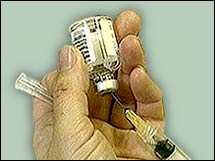No flu shot shortage ... this yearDrugmakers ramping up flu vaccine production this year with only minor glitches, but will over stocking kill future supply?NEW YORK (CNNMoney.com) -- Here's the good news for consumers: There's no flu vaccine shortage this year; in fact, 2006 will probably be a record year for vaccine production. Here's the hitch. If the record-high vaccine production leads to vaccine over-supply, then it could translate into bad news for investors. If that happens, drugmakers aren't likely to bow to government pressure to ramp up supply next year, and consumers could be facing a shortage once again in 2007.
Drug makers are expected to flood the U.S. market with more than 115 million doses of influenza vaccine for the 2006 flu season, far in advance of the 81 million doses distributed last year, according to the Centers for Disease Control and Prevention in Atlanta. "The main thing is we anticipate more vaccine this year than ever before," said CDC spokesman Curtis Allen. The previous high was 83 million doses in 2003. French drug giant Sanofi-Aventis (down $0.14 to $42.29, Charts) is expected to ship 50 million doses, followed by Swiss drug maker Novartis (up $0.31 to $60.88, Charts) and its subsidiary Chiron with 40 million, British company GlaxoSmithKline (up $1.10 to $54.08, Charts) and its Canadian subsidiary ID Biomedical with 25 million, with 3 million from MedImmune (up $0.00 to $32.17, Charts), according to the CDC and the companies. Glaxo is tripling its output from last year. The increase in volume could bring a lift in revenue to the vaccine makers, said Miller Tabak analyst Les Funtleyder, and they aren't likely to suffer from cheapening product due to oversupply because there seems to be plenty of demand. "I don't think anybody is going to miss numbers because there's too much vaccine out there," said Funtleyder. "An oversupply of vaccine is probably is probably not as big a problem as other things, like lack of a pipeline." The exact sales impact of vaccines is difficult to gauge because the companies don't break out the numbers. And there is an economic danger. But if the drugmakers end up with extra stock, it will have to get tossed, because flu strains change every year. So if the companies do suffer from overcapacity this year, Funtleyder said they might refuse to carry out the capacity demands of the U.S. and other governments in 2007. This could once again lead to a shortage or a slow-down. (MedImmune, with only 3 million doses, is least likely to suffer from this problem.) In terms of avoiding a shortage this year, most of the drug companies are shipping the doses out earlier than last year and 2004, when distribution in the U.S. was held up, in part because of production problems with Chiron, a company that has since been absorbed by Novartis. For this season, Allen of the CDC said that 50 million doses had been shipped to U.S. health providers, government offices, drug stores and other recipients by Oct. 20, and the CDC believes it has met its goal of 75 million doses shipped by the end of October. (An October tally is not yet available.) Nonetheless, Allen said the shipping was "a little slower than we would like," partly because the biggest distributor, Sanofi, is running three weeks late. However, this did not appear to being having a tangible effect on overall supply. "We have substantial more doses on the way," said Allen. Sanofi spokeswoman Patty Thomsky said her company expects to have shipped out its 50 million doses by the end of November and is capable of producing more "if demand warrants." Last year, during the shortage that was partly induced by Chiron, Sanofi produced a total of 63 million doses. This year, Chiron's new owner Novartis started shipping in August and had shipped out 15 million doses by the end of September, for a total of 25 million so far, according to Novartis spokesman Eric Althoff. But Novartis has experienced a distribution glitch this season, when a shipment of nearly 20,000 doses was accidentally frozen, which renders the vaccine ineffective, said Allen of the CDC. Allen said the company recalled 500,000 doses "in an abundance of caution," and this did not appear to have a significant slowdown on the company's shipping. Last year ended up having a near-high tally of 81 million doses, but the relatively sluggish rate of shipping meant that many Americans couldn't get their shots as early as they needed them. October and November are considered the ideal months to get flu shots, but the CDC considers any time prior February to be acceptable, because that's the peak month for flu season. During the shortage, President Bush urged Americans to give priority to children and the elderly, who are considered the most susceptible to the flu. |
|

